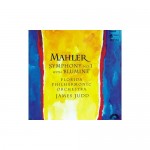
Does South Florida Need Its Own Full-Size Orchestra?
The Orchestra at the Opera House (1870), by Edgar Degas.
The return of James Judd to area concert stages, which will occur in early December when the former Florida Philharmonic conductor leads three performances (one of them at Miami’s Trinity Cathedral) of Handel’s Messiah with the Master Chorale of South Florida and the Boca Symphonia, revives the notion of whether this part of the country needs a full-time major orchestra.
I guess the answer to that depends on what it is you’re looking for. If a good musical experience is what you want, this area now has many chamber-sized orchestras that do fine jobs — the Boca Symphonia, Palm Beach Symphony, the Firebird Chamber Orchestra, the Atlantic Classical Orchestra up on the Treasure Coast, and the two orchestras that play for the Palm Beach and Florida Grand opera companies.
Then there are the larger groups such as the New World Symphony, and two college groups: the Frost Symphony at the University of Miami (which opens Festival Miami on Friday) and the Lynn Philharmonia at Boca Raton’s Lynn University. And each year, a handful of major orchestras from outside, in particular the Cleveland Orchestra at the Knight Concert Hall, make brief local stops.
So there’s plenty of music, and good music, to be had. There are those, too, who argue that full-time orchestras in major cities are an anachronism anyway, rooted in the empire-building days of the late 19th century, when American cities began building opera houses and symphony halls to add Culture with a capital C to their one-time frontier towns.
After Patrick Dupre Quigley, founder of Seraphic Fire, formed the Firebird Chamber Orchestra in 2008 after receiving a $250,000 Knight Foundation grant, he told the press it made much more economic sense to fund small, nimble performing arts groups than big institutions that sooner or later would run into money trouble. About that same time, Ray Robinson of the Palm Beach Symphony was pointing with approval to the example of the Orchestra of St. Luke’s in New York, with its freelance roster and modest size that made it possible for the group to respond to economic and programming challenges quickly and remain within its budget.
Something should be said about the inventiveness of the programming these smaller groups present. Because the biggest symphonies are out of reach, you get to hear a whole swath of repertoire that usually gets ignored when something the Brahms Third is on the bill of fare. Further, some of those big symphonies hold up quite well in smaller groups — Beethoven and Dvorak, for instance — so there’s still plenty of favorites to bring in the box office. The upcoming season for these groups is full of bold, fresh programming, and I’m really looking forward to these concerts.
In addition to these very good smaller ensembles, we have at least one large group in the New World Symphony that often sounds every bit as good as the majors (I’ve heard them in Wuorinen’s Five, a monstrously difficult cello concerto, the Nielsen Sixth Symphony, and the Schubert Ninth, for instance, and they all were spectacular performances). When its new campus is open for business, that will mean a new era, and a higher cultural profile, for what will in all likelihood remain South Florida’s one true major orchestra in the mold of the big-city majors, the only difference being that its young players routinely move on to other jobs rather than stay put for a career.

Although I do love the smaller groups and see the merit of doing things on a budget, and though I do like the fresh programming I’ve heard in the past few years, still there is nothing quite like hearing an old-fashioned big orchestra tear into one of the Romantic showpieces. I’ve been listening today to the 1993 recording the Florida Philharmonic did of the Mahler First (with the discarded Blumine fifth movement) under Judd, and I still like it as much as I ever did. This was a group that did Mahler well, and to hear it again is to be reminded of the days when South Florida had a full-size symphony orchestra all to itself.
I still think a full-size orchestra would be a good thing to have around here again, though I don’t see it happening without a giant endowment suddenly making itself available. Many of the fine musical groups we have here are best-known to devotees of the music, but a symphony orchestra carries a cachet of big-city pride for folks who are non-regulars, or who don’t even go to the concerts in the first place.
It means something major is happening in your town, and for visitors, that’s an impression that lasts. A new full-size South Florida symphony orchestra more than likely would pull this region into another, higher artistic realm, and those who came afterward to check it out would find a much richer, more vibrant music scene around it than anyone but those of us in the know would have been aware.